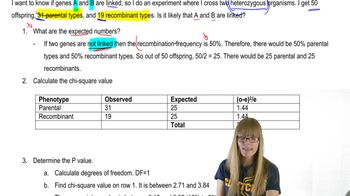T. H. Morgan's data on eye color and wing form genetic linkage between the two genes. Test the genetic linkage (shown in the figure below) data with chi-square analysis, and show that the results are significantly different from the expectation under the assumption of independent assortment.
Table of contents
- 1. Introduction to Genetics51m
- 2. Mendel's Laws of Inheritance3h 37m
- 3. Extensions to Mendelian Inheritance2h 41m
- 4. Genetic Mapping and Linkage2h 28m
- 5. Genetics of Bacteria and Viruses1h 21m
- 6. Chromosomal Variation1h 48m
- 7. DNA and Chromosome Structure56m
- 8. DNA Replication1h 10m
- 9. Mitosis and Meiosis1h 34m
- 10. Transcription1h 0m
- 11. Translation58m
- 12. Gene Regulation in Prokaryotes1h 19m
- 13. Gene Regulation in Eukaryotes44m
- 14. Genetic Control of Development44m
- 15. Genomes and Genomics1h 50m
- 16. Transposable Elements47m
- 17. Mutation, Repair, and Recombination1h 6m
- 18. Molecular Genetic Tools19m
- 19. Cancer Genetics29m
- 20. Quantitative Genetics1h 26m
- 21. Population Genetics50m
- 22. Evolutionary Genetics29m
4. Genetic Mapping and Linkage
Chi Square and Linkage
Problem 30a
Textbook Question
A Drosophila experiment examining potential genetic linkage of X-linked genes studies a recessive eye mutant (echinus), a recessive wing-vein mutation (crossveinless), and a recessive bristle mutation (scute). The wild-type phenotypes are dominant. Trihybrid wild-type females (all have the same genotype) are crossed to hemizygous males displaying the three recessive phenotypes. Among the 20,765 progeny produced from these crosses are the phenotypes and numbers listed in the table. Any phenotype not given is wild type.

Determine the gene order and identify the alleles on the homologous X chromosomes in the trihybrid females.
 Verified step by step guidance
Verified step by step guidance1
Step 1: Begin by identifying the parental phenotypes and recombinant phenotypes. Parental phenotypes are the most frequent, while recombinant phenotypes are less frequent. From the data, the most frequent phenotypes are 'Echinus' (8576) and 'Scute, Crossveinless' (8808). These represent the parental combinations.
Step 2: Determine the double crossover phenotypes, which are the least frequent. In this case, the phenotypes 'Scute, Crossveinless, Echinus' (4) and 'Wild type' (1) are the double crossover events.
Step 3: Use the double crossover phenotypes to deduce the gene order. Compare the double crossover phenotypes to the parental phenotypes. The gene that appears to be 'switched' in the double crossover relative to the parental phenotypes is the middle gene. Analyze the combinations to identify the middle gene.
Step 4: Assign the alleles to the homologous X chromosomes in the trihybrid females. The trihybrid females are heterozygous for all three genes. Based on the gene order determined in Step 3, assign the wild-type alleles and mutant alleles to the homologous chromosomes.
Step 5: Verify the gene order and allele assignments by calculating recombination frequencies between pairs of genes. Use the phenotype counts to calculate the recombination frequencies and ensure they align with the expected gene order. Recombination frequency is calculated as (number of recombinant progeny / total progeny) × 100.
 Verified video answer for a similar problem:
Verified video answer for a similar problem:This video solution was recommended by our tutors as helpful for the problem above
Video duration:
2mPlay a video:
Was this helpful?
Key Concepts
Here are the essential concepts you must grasp in order to answer the question correctly.
Genetic Linkage
Genetic linkage refers to the tendency of genes located close to each other on the same chromosome to be inherited together during meiosis. This phenomenon can affect the expected ratios of offspring phenotypes, as linked genes do not assort independently. Understanding linkage is crucial for analyzing the results of genetic crosses, especially when determining gene order and mapping distances between genes.
Recommended video:
Guided course

Chi Square and Linkage
Recessive and Dominant Alleles
In genetics, alleles can be classified as dominant or recessive based on their phenotypic expression. Dominant alleles mask the effect of recessive alleles in heterozygous individuals, leading to the expression of the dominant trait. In the context of the Drosophila experiment, the wild-type phenotypes are dominant, while the mutations (echinus, crossveinless, scute) are recessive, which is essential for interpreting the progeny phenotypes.
Recommended video:
Guided course

Variations on Dominance
Phenotypic Ratios and Chi-Square Analysis
Phenotypic ratios are the proportions of different phenotypes observed in the offspring of a genetic cross. Analyzing these ratios helps determine whether the observed data fit expected ratios based on Mendelian inheritance. Chi-square analysis can be employed to assess the goodness of fit between observed and expected ratios, aiding in the identification of gene order and the presence of linkage among the studied traits.
Recommended video:
Guided course

Chi Square Analysis

 7:33m
7:33mWatch next
Master Chi Square and Linkage with a bite sized video explanation from Kylia
Start learningRelated Videos
Related Practice
Textbook Question
671
views
